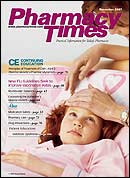Publication
Article
Pharmacy Times
ARTHRITIS WATCH
Cardio Exercise Also Good for Knee OA
The effects of physical activity on the knees of patientswith osteoarthritis (OA) have been debated among expertsfor years. Some claim that exercise can promote knee OA,and others suggest that it has a protective effect. A team ofresearchers in Australia decided to use magnetic resonanceimaging (MRI) to evaluate the effects of exercise on theknees of 257 healthy adults between the ages of 50 and 79years with no past history of knee injury or OA.
The patients were recruited from the MelbourneCollaborative Cohort Study, an established communitybasedresearch population. They all underwent MRI scanson their "dominant knee"—the one used on the first stepwhen they start walking. They also were asked specificquestions about their exercise and walking habits and aboutroutine activities at home and work to determine their levelsof physical activity 6 months and then 7 days prior to thestart of the study.
The MRI results enabled the researchers to assess theeffects of exercise on the patients' knee cartilage, includingany defects or loss of volume, which are linked to worseningOA symptoms. The researchers found that both past andpresent vigorous physical activity was associated with anincrease in cartilage volume without defects. Recentweight-bearing exercise also was related to increased cartilagevolume and fewer defects. The findings were publishedin the October 2007 issue of Arthritis Care & Research.
CDC Presents State-by-state Data onArthritis Limitations at Work
Arthritis is the most frequent cause of disability in theUnited States, limiting the activities of nearly 19 millionadults. According to a Centers for Disease Control andPrevention (CDC) study, work limitation due to arthritis in allworking-age adults ranges from a low of 3.4% in Hawaii to ahigh of 15% in Kentucky. The study, "State-specific Prevalenceof Arthritis-attributable Work Limitation (AAWL)—UnitedStates, 2003," was released in the CDC's Morbidity andMortality Weekly Report (October 12, 2007).
The data cover adults aged 18 to 64 years in all 50 states,the District of Columbia, and US territories. The study examinedall working-age adults in each state who experiencework limitations due to arthritis and was conducted usingself-reported data from the 2003 Behavioral Risk FactorSurveillance System survey.
The prevalence of AAWL ranged from 25.1% in Nevada to51.3% in Kentucky. Variations across states may be related todifferences in prevalence of arthritis across states or to thepredominance in some states of certain occupations that canworsen arthritic symptoms, such as mining, manufacturing,and agriculture.
Mind over Matter: Meditation CanRelieve RA Symptoms
Patients who suffer from rheumatoid arthritis (RA) are alwayson the lookout for ways to relieve their painful symptoms. Arecent study has shown that an ancient method of contemplationis helping some patients find relief.
Researchers at the University of Maryland School ofMedicine set out to determine the effect of meditation therapyon various manifestations of RA, including depressive symptoms,psychological distress, and disease activity. Theresearchers looked at participants in the Mindfulness-BasedStress Reduction (MBSR) program at the University ofMassachusetts Medical School and studied 63 adult patientswith RA (average age 54 years) with no past history of psychiatricillness or other chronic pain disorders. Thirty-one patientstook part in intensive MBSR therapy for a total of 12 weeks.
Researchers compared symptoms among those who participatedin the therapy and those who did not, at baseline, 2months, and 6 months. Those who underwent the therapywere found to have continued benefits at 6 months. The therapyhad no physical effect on RA disease activity, however. Thefindings were published in the October 2007 issue of ArthritisCare & Research.
RA Risk Is in the Genes
Researchers in the United States andSweden have found a genetic regionthat is linked to a patient's increasedrisk of developing rheumatoid arthritis(RA). The US study involved 908 bloodsamples from RA patients involved inthe North American RheumatoidArthritis Consortium and samples from1282 patients without the disease. TheSwedish researchers compared 676samples from patients enrolled in theSwedish Epidemiological Investigationof Rheumatoid Arthritis with those from673 controls.
The samples were analyzed for smalldifferences in DNA distributed throughouta person's genetic code that mightlead to a common factor in RA patients.Both groups of investigators found aregion of chromosome 9 containing 2genes relevant to chronic inflammation.The results were published in theNew England Journal of Medicine(September 27, 2007).
F A S T F A C T : Smoking doubles the risk of developing rheumatoid arthritis.







